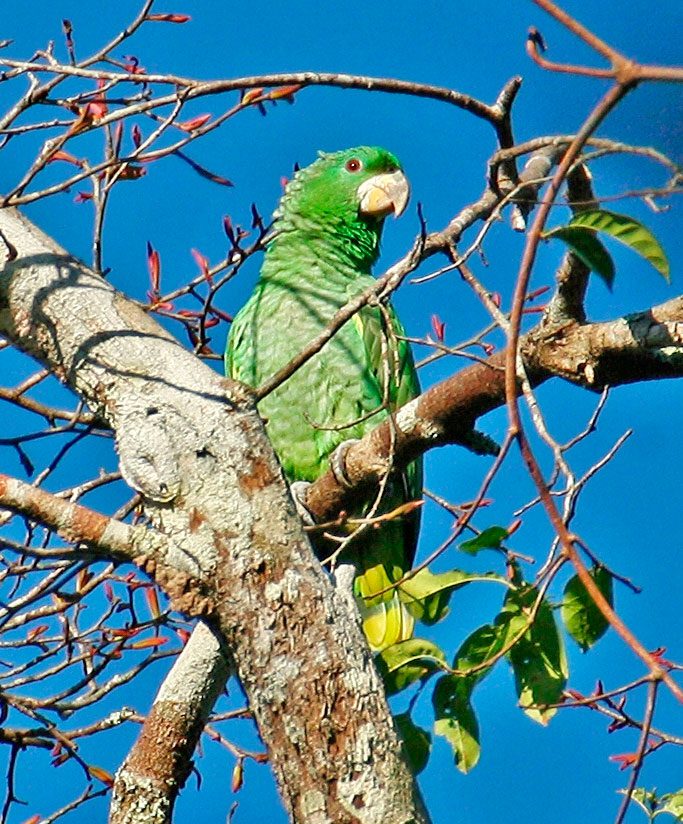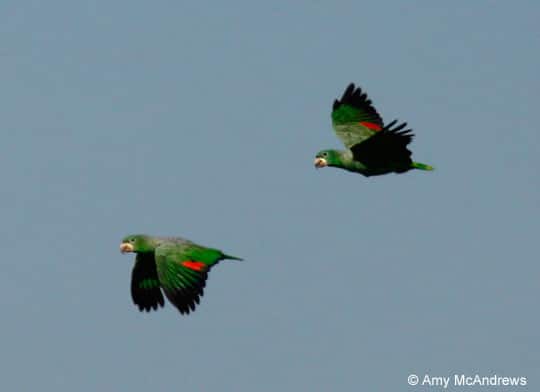Content |
|---|
Description:
35-36 cm.. length.
The Kawall's Parrot (Amazona kawalli) after not having been recorded in the wild for a few 70 years, It was rediscovered in the early 1980.
Wrongly confused with Southern Mealy Parrot (Amazona farinosa) which differs from the remarkable white band at the base of bill.
They have forecrown, the lores, the cheeks and ear-coverts green, although in some birds appear blackish. The crown, sides and back of the neck, as well as the nape, They are green with broad blackish margins to feathers, giving the whole a intricate scaly appearance, with escalation most pronounced in the nape and the the mantle.
Upperwing-coverts green, with the coverts smaller and medium dark shades showing weak at tips; some feathers yellowish green in the leading edge of wing . Primaries green with black towards the tips and some blue in outerweb (a specimen with primary external bright yellow in a wing); red in the three secondaries External form a speculum bright. The underparts They are green with scaling effect derived from the blackish tips to the feathers on the sides of the low chest; some feathers with dark tips in the middle of the chest although little visible; undertail-coverts, more greenish yellow. Upper, the tail It is green with wide band terminal greenish yellow, lateral feathers variably marked dark red (sometimes lined with black-brown and blue) in basal half; undertail, the tail similar but slightly off.

Bill gray bare skin cream in the base and a cream patch on the upper jaw; irises reddish-orange; legs gray.
The male has the lores and perhaps gray bill largest. Immature not described.
- Sound of the Kawall's Parrot.
Habitat:
The Kawall's Parrot They inhabit tropical rainforests, with apparent preference for river edges and permanently flooded forests (igapó).
Reproduction:
Nests observed in tree cavities flooded forest
Food:
Foods reported include seeds trees Hevea brasiliensis and H. spruceana, mesocarpio palm fruit Maximiliana maripa and seeds of Eichleria and Joannesia.
Distribution:
Size of its range (breeding/resident ): 1,160,000 km2
The few published records come from the Amazon basin of Brazil; on top of Juruá (under Eirunepé), in the amazon; the confluence of roosevelt river and Aripuanã River, to the South of For; and southern Santarém, For.
Possibly they overlooked in the field due to morphological similarities with some of the best known and there are almost certainly more individuals than congeners the few records suggest. Distribution map based on alleged occurrence among localities known. No details on the population or condition.
Conservation:
State of conservation ⓘ |
||
|---|---|---|
 Near Threatened ⓘ (UICN)ⓘ
Near Threatened ⓘ (UICN)ⓘ
| ||
• Current category of the Red List of the UICN: Near-threatened.
• Population trend: Stable.
Rationale for the Red List category
Based on a model of future deforestation in the Amazon basin and the susceptibility of the species to habitat fragmentation and hunting , It suspected population decline by 25-30% in the next three generations and, therefore, It has risen to Near Threatened.
Justification of the population
The size of the world's population has not been quantified, but this species is described as “rare” (Stotz et to the., 1996).
Justification of trend
It is suspected that this species has lost 19.1-33.6% of habitat suitable within their distribution during three generations (37 years), based on a model of Amazon deforestation (Soares-Filho et to the., 2006, Bird et to the., 2011). But, it is considered that the species has a wider distribution than indicated on the map used in this analysis (A. Lees in litt 2011), As it suspected to decline by 25-30% during three generations.
Conservation Actions Underway
The species in Appendix II CITES.
Conservation Actions Proposed
First of all, expand the network of protected areas to effectively protect the IBA. Second manage more effectively the resources and existing and new protected areas, using the emerging opportunities for funding the management of protected areas with the overall goal of reducing carbon emissions and maximize the conservation of biodiversity. Especially relevant conservation on private land, through the expansion of market pressures for proper land management and prevention of deforestation on land not suitable for agriculture (Soares-Filho et to the., 2006). Campaign against proposed changes to Brazilian Forest Code that would lead to a decrease in the width of protected riparian forest areas such as Permanent Preservation Areas (APPs), that function as vital corridors in fragmented landscapes.
"Kawall's Parrot" in captivity:
The Kawall's Parrot It is a half-noisy parrot, not very active and hard chewing. They can easily tame. They are not common in aviculture. They are hardy once acclimated. Its minimum temperature tolerance is 15 degrees. Any lower temperature than this requires supplemental heat until the Parrot has acclimatized.
Alternative names:
– Kawall’s Amazon, Kawall’s Parrot, Kawall’sParrot, White-cheeked Amazon, White-faced Amazon (English).
– Amazone de Kawall (French).
– Kawallamazone, Stromamazone (German).
– papagaio-dos-Garbes (Portuguese).
– Amazona de Kawall, Loro de Kawall, Loro de Kawallí, Amazonas de mejillas blancas,
loro de garbes (español).
scientific classification:

– Order: Psittaciformes
– Family: Psittacidae
– Genus: Amazona
– Scientific name: Amazona kawalli
– Citation: Grantsau & Camargo, 1989
– Protonimo: Amazona kawalli
Kawall's Parrot images:
Videos Kawall's Amazon:
Sources:
- Avibase
- Parrots of the World – Forshaw Joseph M
- Parrots A Guide to the Parrots of the World – Tony Juniper & Mike Parr
- Birdlife
Photos:
(1) – Kawall’s Amazon at Rio Cristalino, Mato Grosso, Brazil by Jacek Kisielewski [CC BY-SA 3.0], via Wikimedia Commons
(2) – Kawall’s Parrot (Amazona kawalli) Cristalino Jungle Lodge, Mato Grosso, Brazil by Amy McAndrews – Flickr
(3) – ROLF GRANTSAU* and HÉLIO F. DE ALMEIDA CAMARGO** Museum of Zoology of the University of São Paulo CP 7172, Sao Paulo, Brazil – NEW BRAZILIAN AMAZON SPECIES
Sounds: Jeremy Recall, XC313948. accessible www.xeno-canto.org/313948




Rare in aviculture